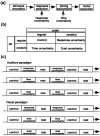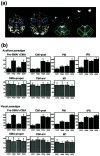What and when: parallel and convergent processing in motor control
- PMID: 10729350
- PMCID: PMC6772247
- DOI: 10.1523/JNEUROSCI.20-07-02691.2000
What and when: parallel and convergent processing in motor control
Abstract
Successful motor behavior requires making appropriate response (response selection) at the right time (timing adjustment). Earlier psychological studies have suggested that the response selection and timing adjustment processes are performed serially in separate stages. We tested this hypothesis using functional magnetic resonance imaging. The subjects performed a choice reaction time task in four conditions: two (on-line response selection required or not) by two (on-line timing adjustment required or not). We found that the neural correlates for the two processes were indeed separate: the anterior medial premotor cortex (presupplementary motor area) was selectively active in response selection, whereas the cerebellar posterior lobe was selectively active in timing adjustment. However, the functional separation was only partial in that the lateral premotor cortex and the intraparietal sulcus were active equally for response selection and timing adjustment. The lateral premotor cortex was most active when both processes were required, suggesting that it integrates the information on response selection and the information on timing adjustment; alternatively, it might contribute to the allocation of attentional resources during dual information processing. The intraparietal sulcus was equally active when either response selection or timing adjustment was required, suggesting that it modifies, rather than integrates, these processes. Furthermore, our results suggest that these activations related to response selection and timing adjustment were distinct from sensory or motor processes.
Figures






References
-
- Allen G, Buxton RB, Wong EC, Courchesne E. Attentional activation of the cerebellum independent of motor involvement. Science. 1997;275:1940–1943. - PubMed
-
- Barbas H, Pandya DN. Architecture and frontal cortical connections of the premotor cortex (area 6) in the rhesus monkey. J Comp Neurol. 1987;256:211–228. - PubMed
-
- Bates JF, Goldman-Rakic PS. Prefrontal connections of medial motor areas in the rhesus monkey. J Comp Neurol. 1993;336:211–228. - PubMed
-
- Benedict RHB, Lockwood AH, Shucard JL, Shucard DW, Wack D, Murphy BW. Functional neuroimaging of attention in the auditory modality. NeuroReport. 1998;9:121–126. - PubMed
-
- Blatt GJ, Andersen RA, Stoner GR. Visual receptive field organization and cortico-cortical connections of the lateral intraparietal area (area LIP) in the macaque. J Comp Neurol. 1990;299:421–445. - PubMed
Publication types
MeSH terms
LinkOut - more resources
Full Text Sources
